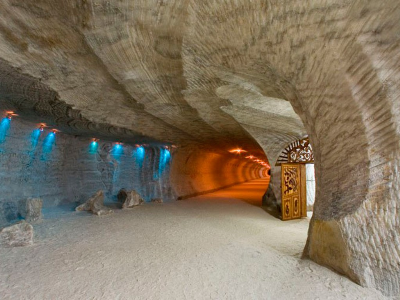
© https://shotam.info
У містечку Соледар на Донеччині розташовані одні з найбільших у Європі соляних шахт. Видобуток тут розпочався ще 1881 року, а згодом було створено державне підприємство «Артемсіль», яке до 2022 року забезпечувало понад 90% солі на українському ринку й активно експортувало продукцію до Європи. За більш ніж 140 років у надрах землі було видобуто близько 250 мільйонів тонн солі, а розвідані запаси оцінюються в понад 5 мільярдів тонн. Підземна мережа шахт простягається на понад 200 км, місцями на глибині до 300 метрів. Камери в деяких локаціях сягають висоти 30–40 метрів — завдяки цим масштабам шахти отримали назву «підземного міста». До повномасштабної війни тут діяли туристичні маршрути, музей, підземна каплиця, концертна зала, навіть футбольне поле з полотном із чистої солі. В умовах постійної температури (+14–15°C) та стабільної вологості працював спелеосанаторій «Соляна симфонія» — популярне місце для лікування бронхіальної астми, алергії та респіраторних захворювань. Концертна зала шахти вражала унікальною акустикою та масштабами — її порівнювали з кількома театрами водночас. Окрему сторінку історії займає підземна церква Вознесіння Господнього, заснована ще у XIX столітті на глибині 300 метрів. Її вважають однією з найглибших православних святинь у світі. Після повномасштабного вторгнення Росії в 2022 році промислову діяльність у Соледарі зупинено, інфраструктура зазнала обстрілів, частина галерей — зруйнована. Місто нині тимчасово окуповане. До війни соляні шахти Соледара були однією з найпопулярніших туристичних атракцій Східної України — місцем, де поєднувалися природа, інженерна майстерність і культурна пам’ять.
The Salt Labyrinths of Soledar: Ukraine’s Underground Wonder
In the town of Soledar, located in Ukraine’s Donetsk region, lie some of the largest salt mines in Europe. Salt extraction began here in 1881, later giving rise to the state-owned enterprise Artemsil, which by 2022 supplied over 90% of Ukraine’s salt and exported to markets across Europe. Over 140 years, around 250 million tonnes of salt were mined, with estimated reserves exceeding 5 billion tonnes — making these deposits virtually inexhaustible. The underground network stretches over 200 kilometers, reaching depths of up to 300 meters. Some chambers rise 30–40 meters high, creating a true "underground city." Until the full-scale Russian invasion, the mines were a popular tourist attraction. Visitors could explore underground routes, a museum, a chapel, a concert hall, and even a football field with a surface made of pure salt. With a constant temperature of 14–15°C and humidity around 60%, the "Salt Symphony" speleosanatorium used the natural microclimate to treat asthma, allergies, and respiratory diseases. Its unique acoustics and massive scale made the concert hall comparable to several world-class theaters. One of the historical highlights is the underground Church of the Ascension, built in the 19th century at a depth of 300 meters — considered one of the world’s deepest Orthodox shrines. Following Russia’s full-scale invasion in 2022, operations at the mine were halted due to shelling. Parts of the galleries were damaged, and the city is currently under temporary occupation. Before the war, Soledar’s salt mines stood as one of Eastern Ukraine’s most fascinating travel destinations — a space where nature, engineering, and culture intertwined beneath the surface.
3591